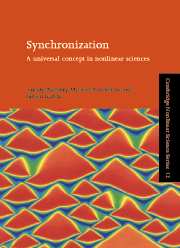Book contents
- Frontmatter
- Contents
- Preface
- Chapter 1 Introduction
- Part I Synchronization without formulae
- Part II Phase locking and frequency entrainment
- Chapter 7 Synchronization of periodic oscillators by periodic external action
- Chapter 8 Mutual synchronization of two interacting periodic oscillators
- Chapter 9 Synchronization in the presence of noise
- Chapter 10 Phase synchronization of chaotic systems
- Chapter 11 Synchronization in oscillatory media
- Chapter 12 Populations of globally coupled oscillators
- Part III Synchronization of chaotic systems
- Appendices
- References
- Index
Chapter 10 - Phase synchronization of chaotic systems
Published online by Cambridge University Press: 06 July 2010
- Frontmatter
- Contents
- Preface
- Chapter 1 Introduction
- Part I Synchronization without formulae
- Part II Phase locking and frequency entrainment
- Chapter 7 Synchronization of periodic oscillators by periodic external action
- Chapter 8 Mutual synchronization of two interacting periodic oscillators
- Chapter 9 Synchronization in the presence of noise
- Chapter 10 Phase synchronization of chaotic systems
- Chapter 11 Synchronization in oscillatory media
- Chapter 12 Populations of globally coupled oscillators
- Part III Synchronization of chaotic systems
- Appendices
- References
- Index
Summary
So far we have considered synchronization of periodic oscillators, also in the presence of noise, and have described phase locking and frequency entrainment. In this chapter we discuss similar effects for chaotic systems. The main idea is that (at least for some systems) chaotic signals can be regarded as oscillations with chaotically modulated amplitude and with more or less uniformly rotating phase. The mean velocity of this rotation determines the characteristic time scale of the chaotic system that can be adjusted by weak forcing or due to weak coupling with another oscillator. Thus, we expect to observe phase locking and frequency entrainment for this class of systems as well. It is important that the amplitude dynamics remain chaotic and almost unaffected by the forcing/coupling.
The effects discussed in this chapter were initially termed “phase synchronization” to distinguish them from the other phenomena in coupled (forced) chaotic systems (these phenomena are presented in Part III). As these effects are a natural extension of the theory presented in previous sections, here we refer to them simply as synchronization.
In the following sections we first introduce the notion of phase for chaotic oscillators. Next, we present the effect of phase synchronization of chaotic oscillators and discuss it from statistical and topological viewpoints. We consider both entrainment of a chaotic oscillator by a periodic force and mutual synchronization of two nonidentical chaotic systems. Our presentation assumes that the reader is familiar with the basic aspects of the theory of chaos.
- Type
- Chapter
- Information
- SynchronizationA Universal Concept in Nonlinear Sciences, pp. 247 - 265Publisher: Cambridge University PressPrint publication year: 2001

